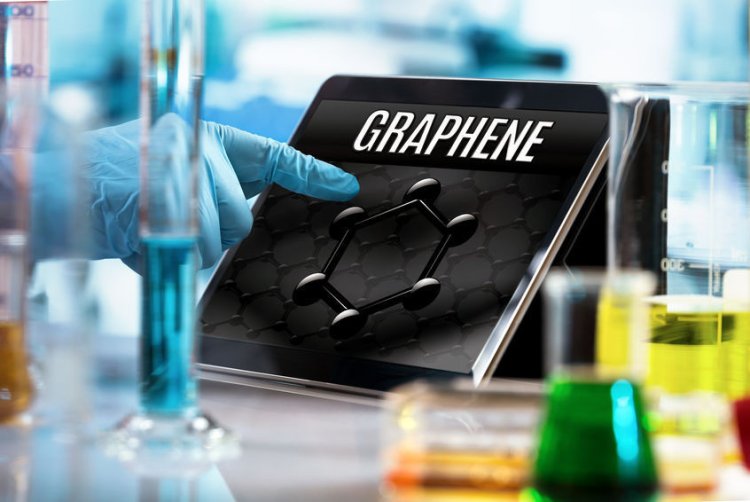In Russia, 2021 was announced as Year of Science and Technology, with June, according to the Year’s schedule, dedicated to new production technologies and materials. Today, we are going to talk about one of the most promising materials — graphene.
Graphene is the thinnest of all materials ever discovered. It was first produced in the early 2000s, and in 2010, Andrey Geim and Konstantin Novoselov of the University of Manchester, alumni of Moscow Institute of Physics and Technology (MIPT), were awarded the Nobel Prize in Physics for the discovery. There is a lot of ideas as to how this thin and very strong material, which has been talked about so much in recent years, could be used.
ATOM-THIN CARBON LAYER
Graphene is only one atom thick — it is the thinnest material in the world and could be called a two-dimensional object. Imagine a normal pencil lead you write with — it consists of millions of graphene layers. Essentially, a graphite pencil lead is a stack of graphene layers. Therefore, everyone has held graphene in their hand at least once in their life. The material was discovered by Gem and Novoselov as they investigated graphite conductivity. The scientists managed to isolate one layer of graphene by sticking a Scotch tape to a piece of graphite.
Isolating a graphene layer with a Scotch tape was a spontaneous idea. Pieces of Scotch tape, used to prepare graphite samples for work with a scanning tunneling microscope, normally go into the garbage bin after the procedure. However, Novoselov and Geim decided to find another application for a piece of Scotch tape with a thin residue of the material, which later won them the jocular title of garbage scientists.
“No-one believed in the possibility of separating one layer. Lev Landau and Rudolf Peierls proved seventy years ago that such materials could not exist: the forces of interaction between atoms must crush them into an accordion or roll into a tube.” Forbes. However, graphene proved to be an exception to this rule.
PRACTICAL APPLICTION
Graphene is believed to have, potentially, many different practical applications. It could be used to make implants for the brain; it could be used in a cooling system for satellites; graphene could be turned into a superconductor; it could have domestic use as well, e.g. as hair dye. Graphene is already used in electronics and medicine: work on neurodevices and biosensors has been ongoing since 2008, though it is hard to say when graphene bioelectronic devices will be used en masse.
The material is especially valued for its strength and elasticity. Besides, graphene is very transparent: its transparency is 97%.
“There is a lot of ideas on how graphene could be used. Some people thought that it could be used as a transistor to replace the element base in modern electronics.
But that did not work out as far as I know, and now, they are trying to use graphene’s elastic properties. If we compare the atomic layer of carbon (which is what graphene is essentially) and the atomic layer of, let’s say, aluminum, we’ll see that graphene is at least ten times as hard. Being monoatomic, graphene transmits light, i.e. you can see through it very well. On the other hand, it’s strong enough to provide necessary protection from mechanical impact. Therefore, graphene could be used as a transparent but durable screen to protect liquid-crystal displays, for example. Its strength could be useful in creating flexible, shatterproof screens, urban structures, etc. Perhaps, it is going to become a building material for spacecraft, public transport vehicles, etc,” Igor BURMISTROV, Deputy Director of the Landau Institute for Theoretical Physics of the Russian Academy of Sciences, said in an interview.
Some experts believe that graphene may even trigger a new leap forward in human civilization. According to scientists, the Silicon Era is close to its end since the silicon element base used to create equipment today is approaching its technological and physical limit, while graphene may make an excellent alternative in this sense. The use of graphene in electronics would help create more powerful computers and systems. Graphene is being used to make flexible mobile phones already.
Metalworking brought a radical change to people’s lives — the same fate is predicted to graphene, which is referred to as the most mysterious and promising new material of the future, which can cause a revolution in the energy sector. Graphene offers an entirely new way of producing energy. The material can let through positively charged carbon atoms, but is impermeable to other gases, including hydrogen itself. This offers incredible prospects to scientists in terms of creating hydrogen-based fuel elements. For instance, hydrogen from the air could be accumulated in such elements to produce electricity and water using graphene, with practically no waste generated.
American physicists showed last year that graphene could be used to harvest energy: graphene can generate energy using the environment. Scientists of the University of Arkansas developed a circuit capable of capturing graphene’s thermal motion and converting it into an electrical current.
“An energy-harvesting circuit based on graphene could be incorporated into a chip to provide clean, limitless, low-voltage power for small devices or sensors,” said Paul Thibado, professor of physics, who was involved in the experiment.
Graphene could be used to create quantum computers and make them smaller. Graphene can be used to produce consumer goods, e.g. clothing. Graphene clothes, light and dense, are available on global markets even today.
Graphene future
According to Yevgeny Ametistov, research supervisor at the Corporate Energy University, graphene projects are close to mass introduction in the economy. However, Russia is nowhere near to leadership in the graphene race, and our technologies are far from perfect.
The European Union allocated one billion Euros under its science funding program (2014-2020) for launching industrial-scale graphene production. The project includes 23 countries and 143 research teams and industrial partners. Not so long ago, in 2015, the National Graphene institute opened in Manchester, which was built with the funding from the European Union’s Regional Development Fund and the UK Government. However, China, with its Innovation Alliance of the Graphene Industry, accounts for over a half of the world’s publications and patent applications concerning graphene.
What about Russia? In terms of graphene research projects, Russia is in the 14th place in the world, according to the Russian business weekly Expert. Moreover, the percentage of Russian publications on graphene is declining, Expert says: from 5.6% in the 2000s to as little as 2.3% in 2021.
Over 30 organizations are engaged in graphene research in Russia, including various institutes of the Russian Academy of Sciences, Lomonosov Moscow State University, enterprises of the State Company Roscosmos, and private firms. Russia has its own Graphene Institute, which created the first Russian semi-industrial plant to produce pure (almost 100%) graphene.
“There is a kind of a graphene race going on. Our positions were quite good at the start, Russia being traditionally strong at fundamental physics. I must say that, to some degree, we missed the moment the world leapt forward,” Valentin Volkov, Director of the MIPT Center of Photonics and Two-Dimensional Materials, said at the international conference on two-dimensional materials in Sochi.
Even today, graphene and graphene-like materials are used in Russia to increase the shock strength of experimental models of silicon carbide armor for attack helicopters and military helmets, and to produce sun panels, li-ion batteries, etc. However, the mass use of graphene is still in the future.
Photo: angellodeco / 123RF






















